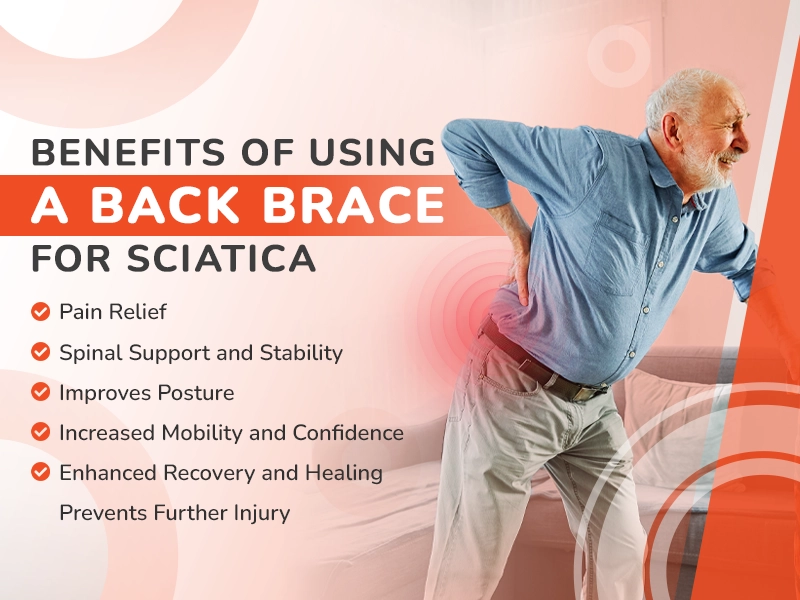Sciatica is a common yet painful condition that affects millions of people worldwide, causing sharp, radiating pain that starts in the lower back and travels down the legs. This discomfort is often the result of pressure on the sciatic nerve, typically due to a herniated disc, spinal stenosis, or muscle inflammation. For those struggling with sciatica, even simple daily activities like standing, walking, or bending can become challenging. While various treatment options exist, many individuals turn to back braces as a non-invasive way to manage their symptoms and regain mobility.
Back braces are designed to provide targeted support, improve posture, and reduce strain on the lower spine, all of which can help alleviate sciatic pain. By stabilizing the lumbar region, these braces minimize unnecessary movement and promote spinal alignment, potentially easing pressure on the sciatic nerve. But do they truly offer lasting relief? In this article, we’ll explore the effectiveness of back braces for sciatica, their benefits, limitations, and how to use them as part of a comprehensive pain management plan.
Understanding Sciatica and Its Causes
Sciatica is a common yet often misunderstood condition that causes significant discomfort and disruption to daily life. In this comprehensive guide, we’ll break down everything you need to know about sciatica, from its definition to its causes, symptoms, and treatment options. Whether you’ve been diagnosed with sciatica or are seeking to better understand it, this article will provide valuable insights to help you manage and reduce the impact of this condition.
What is Sciatica?
Sciatica refers to pain that radiates along the path of the sciatic nerve, which runs from the lower back, through the hips, and down each leg. This nerve is the longest in the body, and when it becomes irritated or compressed, it can cause a range of symptoms, from mild discomfort to intense pain.
Unlike common back pain, sciatica specifically affects one side of the body. The severity of the pain can vary depending on the underlying cause of the nerve irritation, and it may come and go or persist for weeks or even months.
Causes of Sciatica
Sciatica is typically caused by compression or irritation of the sciatic nerve. Common causes include:
- Herniated Disc: A bulging or ruptured disc in the spine presses on the sciatic nerve.
- Spinal Stenosis: Narrowing of the spine that puts pressure on the nerve.
- Degenerative Disc Disease: Wear and tear of spinal discs, leading to nerve compression.
- Spondylolisthesis: A slipped vertebra that affects the nerve.
- Piriformis Syndrome: Muscle spasms in the buttocks irritate the sciatic nerve.
- Trauma or Injury: Accidents or falls that cause nerve damage.
- Pregnancy: Pressure from the growing baby can compress the nerve.
- Lifestyle Factors: Poor posture, obesity, and inactivity can increase risk.
How Back Braces Work for Sciatica Relief
Back braces can be an effective tool for managing sciatica symptoms by providing support and reducing pressure on the spine and sciatic nerve. Here’s how they work:

1. Stabilize the Spine
Back braces help stabilize the lower back by providing external support to the spine. This reduces strain on the muscles and ligaments surrounding the spine, which can alleviate the pressure on the sciatic nerve caused by herniated discs, spinal stenosis, or other underlying conditions.
2. Promote Better Posture
One of the main benefits of wearing a back brace is its ability to encourage proper posture. By keeping the spine aligned, a back brace can help prevent movements that worsen sciatica pain, such as slouching or bending improperly. This can provide long-term relief for those with sciatica triggered by poor posture.
3. Limit Movement and Prevent Further Injury
A back brace can limit excessive movement, especially when lifting or performing activities that could exacerbate sciatica pain. Restricting certain motions prevents further aggravation of the affected nerve, giving the body time to heal.
4. Support Healing
For individuals recovering from an injury, such as a herniated disc or muscle strain, a back brace provides support during the healing process. It helps reduce muscle fatigue, improves circulation, and prevents unnecessary strain on the injured area.
5. Pain Relief
While a back brace won’t cure sciatica, it can offer relief by reducing muscle tension, providing gentle compression, and supporting the lower back. This can help relieve the constant discomfort associated with sciatica, especially during daily activities.
Types of Back Braces for Sciatica
Here’s a breakdown of the most common types of back braces for sciatica, with two key features of each:
1. Lumbar Support Braces
- Targeted Support: Provides targeted support to the lower back, alleviating pressure on the sciatic nerve.
- Lightweight and Adjustable: Comfortable for daily use, with adjustable straps for a customizable fit.
2. Abdominal Binders
- Core Stabilization: Supports both the lower back and abdomen, helping to stabilize the core and reduce strain on the spine.
- Post-Surgery Use: Commonly used after spinal surgery or for conditions like degenerative disc disease to aid recovery.
3. Corset-Style Braces
- Enhanced Support: Rigid construction with metal or plastic stays to provide firm support and limit unnecessary spinal movement.
- Pain Relief for Severe Cases: This treatment is ideal for more severe sciatica, offering substantial back stabilization and pain relief during recovery.
4. Posture Corrector Braces
- Postural Alignment: Encourages proper spinal alignment, which can reduce strain on the sciatic nerve caused by poor posture.
- Discreet and Lightweight: Often worn under clothing, these braces are subtle and suitable for all-day wear.
5. Full Back Braces
- Complete Back Support: Provides comprehensive support for the entire spine, from the lower back to the upper back.
- Maximum Stabilization: Ideal for those with chronic sciatica or after surgery, offering full-body support to limit movement.
6. Dynamic Braces
- Flexible Support: Offers flexibility while still providing enough support to control excessive spinal motion.
- Comfortable for Activity: This allows you to stay active and move freely, which is helpful for moderate sciatica caused by muscle strain.
Each type of back brace offers unique features designed to provide targeted support and relief, so it’s important to choose one that fits your specific needs. Always consult a healthcare professional for personalized recommendations.
Benefits of Using a Back Brace for Sciatica
Using a back brace can provide several advantages for individuals dealing with sciatica, from relieving pain to supporting proper posture. Here are the key benefits:

1. Pain Relief
A back brace helps reduce pressure on the sciatic nerve by stabilizing the lower back and supporting the spine, alleviating pain and discomfort associated with sciatica. Additionally, it helps reduce muscle strain by providing external support, easing the intensity of sciatica symptoms.
2. Spinal Support and Stability
Back braces limit excessive movement, such as bending, twisting, or lifting, which can aggravate sciatica pain. They also encourage proper spinal alignment, preventing poor posture that could worsen the condition and allowing the spine to heal correctly.
3. Improves Posture
A back brace, especially posture correctors, encourages individuals to maintain proper alignment throughout the day. By preventing slouching, it reduces the risk of sciatica flare-ups that result from poor posture and spinal misalignment.
4. Increased Mobility and Confidence
Wearing a back brace gives individuals the confidence to move without the fear of worsening their symptoms, ultimately improving overall function and mobility. For those with mild sciatica, it allows for more comfortable participation in daily activities and light exercise.
5. Enhanced Recovery and Healing
For those recovering from an injury, such as a herniated disc or spinal surgery, a back brace offers critical support during the healing process. It helps protect the spine and prevents further injury, reducing muscle fatigue and promoting quicker recovery.
6. Prevents Further Injury
A back brace reduces unnecessary strain on the spine, helping prevent the worsening of sciatica. It also prevents compensatory movements that could lead to additional injuries, ensuring the spine stays protected while healing.
Read More: Back Brace After Back Surgery: When and How to Use It?
Limitations and Considerations of Using a Back Brace for Sciatica
While back braces can provide relief for sciatica, there are important limitations to consider:
- Not a Long-Term Solution: Prolonged use can weaken lower back muscles, so it’s important to combine the brace with strengthening exercises for long-term relief.
- Discomfort and Movement Restrictions: An ill-fitting or tight brace can cause discomfort and limit mobility, affecting daily activities.
- Does Not Address the Cause: A back brace alleviates symptoms but doesn’t treat underlying issues like herniated discs or spinal stenosis. Other treatments may be necessary.
- May Not Be Effective for Severe Cases: For chronic sciatica, a back brace may not provide enough relief, and additional treatments like therapy or surgery might be needed.
- Proper Fit is Essential: A poorly fitted brace can cause discomfort or injury. Always consult a healthcare professional to ensure proper sizing.
- Skin Irritation: Wearing a back brace for long periods may cause skin irritation, so use a protective layer under the brace.
- Conclusion: Back braces offer short-term relief but should be used alongside other treatments for effective long-term management of sciatica.
Conclusion
Back braces can offer effective short-term relief for sciatica by providing support and improving posture. However, they are not a long-term solution and should be used alongside other treatments like physical therapy and medical care to address the root cause of the condition.
It’s important to ensure the brace fits properly and consult with a healthcare provider before use. If you’re struggling with sciatica and need guidance on finding the right support, contact us today. The Heal Medical Supply is here to help you take the next step toward lasting relief.




